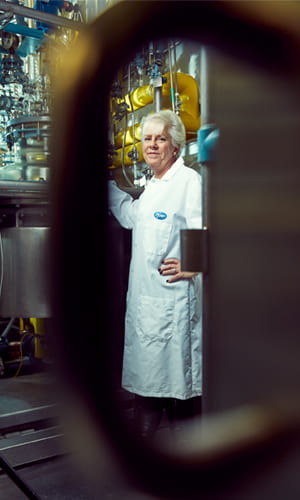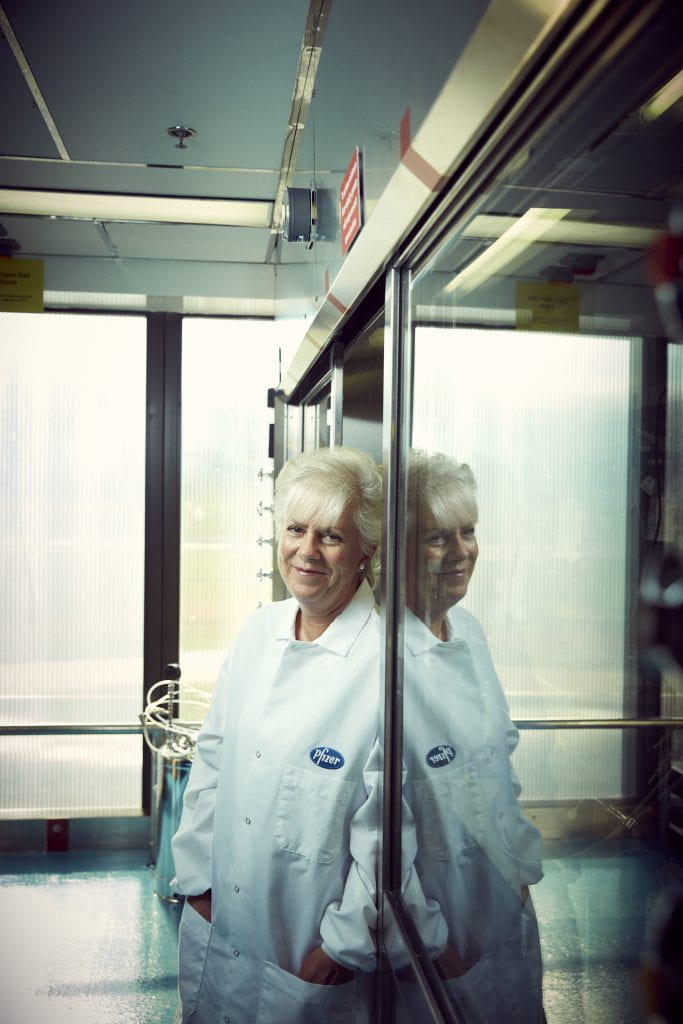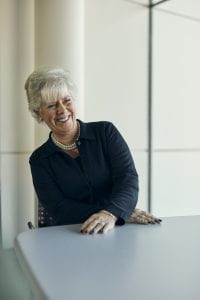Professor Anita Mattson's Passion for Chemistry
“Unlike most people, I find organic reaction mechanisms really fun,” she admits. “I was nervous about...
Read StoryA Pharmaceutical Path
When infusion drug therapy alleviates multiple sclerosis symptoms, or a daily round of antibiotics clears up a child’s painful strep throat, the activity is fairly solitary, and it’s often over quickly. But in each of those drugs is a decade-long history of dozens of people working together to develop, test, and get those drug therapies into the hands of the people who need them most.
Lynne Handanyan thrives on this kind of collaborative approach—and has since her days at WPI. “Drug development is a team sport,” she says. “You have to come together to navigate and solve problems and overcome challenges.”
As vice president of global Chemical R&D for the biopharmaceutical company Pfizer, Handanyan knows each potential drug tasks her team on many levels. “Our teams are increasingly challenged by the molecular complexity of new drug candidates,” she says. “They have to come up with new solutions—chemistry, technology, tools—to successfully manufacture the compounds so they can be studied in clinical trials.”
With so much on the line, time pulls both ways. For human safety, the drugs, no matter how urgently people need them, can’t be rushed through development and testing. Handanyan says innovation and commitment are the pillars of getting new drugs to market.
“We recently worked on a candidate for over eight years,” she says. “The molecule required 37 chemical transformations to convert starting materials to the target drug candidate—in comparison most drugs require 12.” The complexity of developing new drugs only begins there.
“The team needed to work with companies with unique capabilities for purification and isolation to manufacture the drug,” she says. “Creativity, perseverance, patience, teamwork, collaboration—all were required to solve the challenges this program presented.”
It’s About People
For all the complex science, engineering, technology, and marketing that goes into developing medications, therapies, and vaccines, Handanyan says the endgame focus is simple and specific—patients. She says the patients who depend on pharma’s continued progress—those with life-threatening or life-altering diseases, illnesses, or conditions—are always foremost in the minds of the teams responsible for new drug developments.
“We are working on lots of drugs to treat various forms of cancer—from early clinical trials where you can see the impacts those drugs have on people,” she says. Her team’s dedication is rooted in motivation. They internalize the urgency and work intensely for years to get that drug manufactured, registered, and into the hands of people who need it.

For more than three decades, Handanyan’s career has grown at the global pharmaceutical powerhouse, giving her enough choices that she never went to another company. “My career has always been fresh,” she says. “I’ve been exposed to new learning opportunities. And WPI prepared me really well for teamwork and strengthened my ability to work effectively with people having different points of view.”
She knew learning diverse, yet relevant, skills would help her move up in Pfizer’s ranks. “I would volunteer for new responsibilities as a way to learn a new aspect of our business, work with a different group of people, or solve a problem,” she says.
A Natural Choice
By the time Handanyan’s feet hit the Hill in 1982, there’d been women students on campus for more than a decade. There wasn’t exactly a preponderance of women in the classroom, but they did band together to navigate the WPI Plan and college life. That camaraderie with other chem eng students (the majority were women), gave her an instant circle of others who loved chemistry and math and wanted to learn.
“I was a very introverted student in high school,” she says. “WPI and its curriculum gave me a platform to feel more confident in myself. I learned to communicate my work effectively and to feel comfortable collaborating in a group.”
When she got to Pfizer in 1986, she found similar ratios. “Of the 100 or so engineers on staff at Pfizer when I started, maybe five or six were women,” she says. “Now we are in positions of leadership, and we’re hiring more and more female talent into R&D. There are more of us, percentagewise.”
As a woman in a leadership role, Handanyan says supervisors and mentors guided her path by offering greater responsibilities and indispensable advice.
Her earliest office mate at Pfizer, John Hanley ’82, was one of those mentors. He says he was impressed by her academic achievements at WPI, and that even today he recalls one particular comment that heralded what was to come. “I remember her saying that if she was hired, she would want to focus on learning the job really well,” he says.
Hanley, now a quality assurance validation manager with 37 years at Pfizer, helped Handanyan navigate new responsibilities as a production manager. Working in solvent recovery, she oversaw chemical operators working on manufacturing bulk pharmaceutical active ingredients in Pfizer’s Groton, Conn., office (still Handanyan’s base). The facility’s large chemical division manufacturing site produced products such as penicillin, citric acid, caffeine, food enhancers, and many active ingredients for clinical studies for new potential medications.
Hanley says when Handanyan began working with R&D to head the commercial scale-up of a new product, her impressive work “kick-started her rapid advancement.” Hanley’s support was invaluable. “I felt like everyone was invested in my being successful,” she says.
With that experience under her belt, Handanyan applied for a research scientist role. “I decided to take a chance,” she says, even though she didn’t know if her qualifications matched. Intrigued by greater responsibilities and a new path, she knew the move would be beneficial. Pfizer agreed.
Rolling with Change
Handanyan acknowledges that she’s in a rare circle of employee longevity when job hopping is the norm. But she believes in Pfizer’s mission and is proud of being part of this life-saving process. Pfizer, in turn, has nurtured Handanyan’s career through difficult periods.

“The biggest challenge I had was balancing a demanding career with my responsibilities as a mother of three,” she says. She and her husband (James Handanyan ’86—they met while waiting in line for their first class registration) have three sons, ages 26, 24, and 19, and time was always too short to accomplish what she wanted. In a demanding field that attracts perfectionists like herself, Handanyan found that making work-life trade-offs, and acknowledging they were necessary, took some adjustment. “Learning what was good enough and then accepting that it was good enough was a big challenge,” she says.
Today, Pfizer’s global Chemical R&D department spans two countries and has several sites in the United States. Since 2000, Pfizer has merged with or has acquired various companies, allowing Handanyan opportunities to travel to and work with partners internationally.
In the shifting organizational landscape, she had tough decisions to make in deciding how to integrate capabilities across legacy companies. Many times, she had to understand quickly evolving technologies to make the best investments for her current and future lab and manufacturing teams.
From Colds to Cancer
Handanyan’s department has produced a range of products on their journey to be a new medicine: from Xalkori to Xeljanz; Chantix and Ibrance, Vyndaqel and Inlyta. Looking at therapies in the pipeline—including vaccines for many cancers, devastating Clostridium Difficile [C. diff] bacterial infections, plus drug therapies for cancer or alopecia areata—the potential human impact is significant.
When Handanyan talks about pharmaceuticals and people, she has the faces and stories of actual patients and their families in mind. Occasionally, she and her team are fortunate enough to meet those whom the drugs have helped. “Sometimes patients come in,” she says, “and we hear of their journeys with a certain disease and the impacts the products we have developed have had on their lives.”
As a mom, she says parents talking about the pediatric cancer medications leave a profound impression. She remembers one mother who created whimsical messages and images with her son’s overwhelming number of medication bottles to offer an underlying and poignant message about medical treatment. The effect demonstrated just how long, grueling, and painstaking these journeys are. “They are battling such challenges,” she says of the patients.
When a drug is successful, it’s a game changer for some. The FDA approved Pfizer’s recent drug LORBRENA (lorlatinib) in November 2018. Its trial results were so positive for treatment of ALK positive metastatic non-small cell lung cancers that the challenge became an urgent need to get it to market. Her team, along with other Pfizer teams, managed to get the drug from development to final approval in five years—lightning-fast speed in the pharmaceutical world, where the usual track of development to market is normally twice that long.
“We’ve done a lot of investing in innovation and how we do our work over the years,” Handanyan says. “There’s been so much innovation in the work process so that we can now successfully do work in five years that 25 years ago we never could have done.” Drug development walks a fine line of faster production without compromising quality—and then teams must replicate the process on a much larger manufacturing scale to meet commercial demand.
Modern labs look to equipment with automation and data collection to boost innovative results. Seeing this trend, Handanyan championed a $15 million investment in equipment to advance Pfizer’s R&D capabilities and pioneer new drug development. “These capabilities have been game changing for us,” she says.
Innovation brings a faster concept-to-customer path. LORBRENA marked Pfizer’s third FDA-approved oncology treatment within a two-month period, two of which were for lung cancer—the leading cause of cancer deaths.

Learning from Success and Failure
This success is one of many for Pfizer, but it also amplifies a gaping need. “What I have learned about oncology is that cancer is very complicated,” says Handanyan. “The same disease can manifest with different mutations. Drugs are designed to attack one specific mutation and that helps to find a target patient population.”
The drugs that begin in R&D aren’t always successes, but they are opportunities. “I would love it if every drug we developed became a success, but many don’t and we have to accept that,” she says. “Some are spectacular failures, but you reflect on what you do learn and how you will approach the next project in the future.” The science and engineering methodology in drug development, even if it didn’t produce a drug, is often still incredibly valuable. Failure means the next iteration of the process may succeed.
“It’s exciting to work in development when a discovery leads to a compound nominated for development,” she says. Her team sees the full breadth of portfolios across multiple therapeutic areas, including oncology, inflammation and immunology, internal medicine, rare disease, and hospital products—from the earliest inquiry and discovery stages through collaborations with the manufacturing division to produce active ingredients, progress the formula into a deliverable form, and manage regulatory applications for registration.
“I get to do the work I love, and I get to work with talented and dedicated people,” Handanyan says. “The relationships I’ve forged doing work that I love and that’s meaningful to society—I can’t ask for any more than that.”